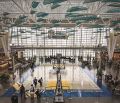Airport Authority Releases Revised Environmental Study on Terminal 1 Replacement Plan
SAN DIEGO – September 19, 2019. The San Diego County Regional Airport Authority today released a revised draft environmental study for the Airport Development Plan (ADP) which envisions the replacement of Terminal 1 with a modern, efficient facility and related improvements to ensure a better customer experience for decades to come.
The revised Draft Environmental Impact Report (DEIR) incorporates new information gathered over the past year through more than 100 meetings with regional partner agencies, community stakeholders and others. The original DEIR was issued in July 2018.
“The Airport Authority is committed to being a collaborative community partner,” said Kim Becker, the Airport Authority’s President/CEO. “That’s why we felt it was necessary to reach out to our stakeholders and do a lot of listening. Then we went back and revised our thinking to make the project work better for everyone.”
One major issue related to the ADP has been transit connectivity to San Diego International Airport (SAN). The Airport Authority believes a strong connection to the region’s transit system is extremely important for its passengers, for the 9,400 people who work at SAN, and for overall traffic circulation in the area around the airport.
To that end, the Airport Authority is working with SANDAG and other regional agencies to assist in their efforts to determine the best transit solution for carrying people to the airport. The Airport Authority has set aside space between the terminals for a transit station that could connect to a project chosen by regional transportation planning agencies.
The designated transit station area will be able to accommodate whatever type of system is ultimately chosen by SANDAG and the other agencies.
In addition, the Airport Authority will launch an all-electric shuttle fleet that will carry transit riders from the Old Town Transit Center to the airport and back. This service is set to launch in early 2020.
The need for the ADP has been fueled by the tremendous growth seen in passenger volumes. When Terminal 1 opened in 1967, it served 2.5 million passengers that year. In 2018, the same facility served more than 12 million.
Its design is dated and inefficient. The new Terminal 1 would be a more modern facility with up to 30 gates – 11 more than the existing Terminal 1. It would offer more gate-area seating, restaurants and shops, as well as additional security checkpoints with more lanes and a host of energy-efficiency upgrades.
A proposed on-airport access road would remove an estimated 45,000 cars per day from North Harbor Drive. The ADP also sets aside right-of-way for outbound lanes.
Examples of other areas of regional concern, and how the Airport Authority is addressing them in the revised DEIR, include:
- Forecast: The official activity forecast that projects growth in passenger numbers and flights has been updated, using data from 2018. The new forecast was approved by the FAA in mid-2019.
- FAA Funding for Off-Airport Improvements: The Airport Authority has submitted a request to the FAA to approve using airport revenues to help fund off-airport roadway and transit projects designed to increase mobility to the airport.
- Parking: The size of a planned parking structure in front of the new Terminal 1 has been reduced by 2,000 spaces, from a maximum of 7,500 spaces to 5,500 spaces (a net increase of only 650 spaces from 2018), to make room for the potential transit station.
- Climate Action Plan: The revised ADP is better aligned with the City’s Climate Action Plan. Initiatives include expanded electric vehicle charging infrastructure, a bicycle path on Harbor Drive and new incentives to promote alternative commuting habits among employees.
- Sea-level Rise: The Airport Authority has completed a plan to address impacts from higher sea levels, more intense rainfall and extreme heat. For example, there is a plan to expand stormwater systems that provide the ability to capture and reuse more than 39 million gallons of rain annually. The Airport Authority is also partnering with Scripps Institution of Oceanography to monitor sea levels using advanced sensors in San Diego Bay.
After a 45-day period to gather public comments on the revised DEIR, the Airport Authority will endeavor to present the report to the Airport Authority Board for certification by early 2020.
The California Coastal Commission and federal environmental approvals processes will follow, and if all approvals are secured, the Airport Authority aims to break ground in 2021 and open the first phase of the new Terminal 1 (19 gates) by 2024.
The revised DEIR can be viewed at san.org/plan, or by clicking here.
FREE Whitepaper
Fairbanks International Airport Baggage Transport Conveyor Enhanced With Mod Drive™ System
Airports face a host of unique industry challenges, such as meeting efficiency regulations and seeking out the best maintenance practices to reduce costs and keep operations flowing. In today’s current economic climate, any potential cost savings can go a long way.
In 2019, Alaska’s Fairbanks International Airport (FAI) sought to modernize its equipment and operations. They were dissatisfied with the performance of the gearmotors on their baggage transport conveyors and began searching for new suppliers. Regal approached FAI with a solution that could improve equipment performance and simplify maintenance, with the added benefit of energy cost savings: the Hub City® MOD Drive™ system.
This white paper discusses the hardware deployed, the test results and the annualized expectations for ROI.








